27. Sep 2019 - DOI 10.25626/0104
Nelly Bekus is Associate Lecturer at the University of Exeter, UK. Her research focuses on postcommunist nation- and state-building, cultural heritage, memory and identity, urban transformation, the religious and the ethno-linguistic landscape in post-Soviet nations. She was a recipient of research fellowships at the Remarque Institute, New York University (2008), at the Davis Center of Russian and Eurasian Studies at Harvard University (2013), and the Aleksanteri Institute at the University of Helsinki (2019-2020). She is author of Struggle Over Identity. The Official and the Alternative Belarusianness, CEU Press, 2010 and Orthodoxy versus Postcommunism (co-authored), Cambridge Scholars, 2016.
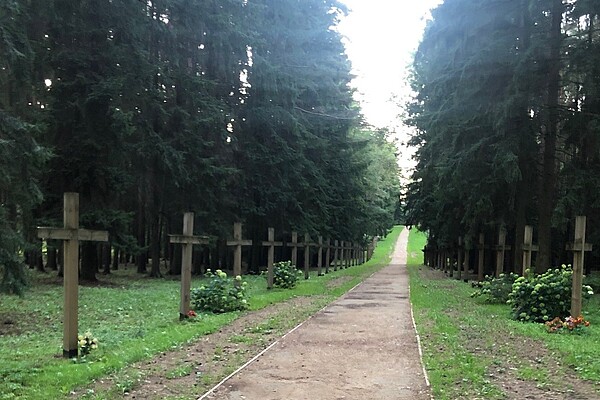
In April 2019, independent media in Belarus reported on the violent removal of memorial crosses from Kurapaty, the site of Stalin-era mass executions on the outskirts of Minsk. Prominent figures, like Noble prize winner Svetlana Aleksievich, Catholic Archbishop Tadeush Kandrusievich and press secretary of the Belarusian Orthodox Church Sergei Lepin, condemned the dismantling of crosses as an act of state vandalism that disrespected the memory of the victims of Stalinism and the feelings of believers for whom the crosses are a sacred symbol. The removal of the crosses was met with great public disapproval, and protests were organised by memory activists from the Belarusian political opposition, much to the surprise of officials. The crosses were removed to build a fence to demarcate the large memorial site, thereby conferring official recognition on the area. In reality, this was the last step in a government-led memorialisation campaign which had started five months earlier. In November 2018, the authorities had inaugurated an official monument at Kurapaty, finally implementing what a decree by the Belarusian Supreme Soviet had stipulated in 1989.
The mass burial site at Kurapaty had been discovered barely a year earlier, in 1988, by archaeologist Zianon Pazniak, who would become the founder of the first anti-communist opposition party, the Belarusian Popular Front (Bielaruski Narodny Front, BPF), and journalist Yauhenii Shmygalyou. It triggered a criminal investigation into the offences of the 1930s; exhumations were carried out; and a government-appointed commissio reviewed archival materials and collected witness testimonies. In the final report, the mass shootings were attributed to the Soviet Security Police (NKVD). Moreover, the territory of the mass graves was registered in 1993 on the list of Belarusian sites of historical cultural heritage, although for nearly thirty years only a small memorial plaque informed visitors of its official status.[1]
Between 1989 and 1994, the BPF initiated a number of laws to rehabilitate and safeguard the memory of the victims of political repression, as well as to consider property restitution and other compensation measures. Yet, this period of official reckoning was short-lived. After Aliaksandr Lukashenka was elected president in 1994, such legislative activities stopped, and official memory politics shifted towards Soviet-era remembrance rituals focused on commemorating the losses of Belarusians during the Second World War, while suppressing public commemoration of those killed under Stalin. Indeed – for two decades, Belarusian authorities refused to engage with the repressive and criminal aspects of the Soviet past.[2]
After so many years of official neglect, the inauguration of an official monument in memory of Stalin-era mass crimes in 2018 generated mixed reactions among the multiple memory activists who, unlike the authorities, had never stopped working for the remembrance of the victims of Stalinism. While some appreciated the arrival of the new monument as a sign of official acknowledgement of Soviet repressions, others saw it as an intrusion into the independent memory space that, until recently, had remained free of pro-Soviet Belarusian state ideology.
Indeed, the new monument should not be mistaken as a sign of a serious shift towards long overdue historical redress. On the contrary, it was merely an attempt to stifle a wider public debate on the political crimes committed in Belarus under Stalin. Building a fence around the execution site can be read as a symbolic attempt to ‘enfold’ the memory of the victims of the Soviet past so that the remembrance of what happened to them would not affect the lives of contemporary Belarusians. The new monument was also meant to silence analogies between past and present political regimes and to end the struggle between various political and social groups to remember.
Two different aspects make the Kurapaty forest an important memory site in Belarus. The first is linked to the site’s physical integrity and the protection of its borders, which acquired greater meaning in the process of memorialisation. The second is related to the multi-vocality of commemorative artefacts placed across the site by various memory actors, which establish and maintain the connection between the living and the dead using various frames of memory representations.
Over the past twenty years, Kurapaty’s integrity was repeatedly threatened. In 2001, a planned widening of the Minsk ring road cut across the Kurapaty area. For 250 days, a group of activists from the BPF and its youth branch the Young Front (malady front) organised a camp to protect the site. Their protest was ultimately successful as the ring road was diverted. The campaign also produced the first civic initiative “For the Protection of Kurapaty”, which later became an important player in memory work in Belarus.
In 2012, a second protest was organised to block the construction of an entertainment centre, the Bulbash Hall, in close proximity to the memorial site. The initiators filed a series of official information requests about the status of the Kurapaty forest as a site of cultural and historical value. At the helm of these inquiries was a newly formed group of activists that called themselves “Experts for the Protection of Kurapaty”. Among them were leaders of the BPF, the Youth Front, Martyralog Belarus, and the Assembly of Non-Governmental Organisations of Belarus (the largest association of pro-democratic non-governmental organisations and civic initiatives in Belarus, founded in 1997). The investigation ultimately revealed that the physical border of the buffer zone around the Kurapaty memorial site had never been formally confirmed due to ministerial negligence. These findings were made public via opposition as well as social media.
In 2017, conflict arose in response to a proposal to build a business centre on land within the buffer zone that had been illegally sold to developers. Several Belarusian oppositional parties, such as the BPF, the Belarusian Christian Democrats, and the United Civil Party – none of which are able, under the authoritarian regime, to operate as a parliamentary opposition and thus exist in a parallel world of alternative politics in Belarus – organised a series of protests that resulted in the retraction of the construction plan.
Only a year later, the controversial entertainment centre was transformed into a restaurant called Poyedem poedim (Let’s go and eat), the opening of which was, once again, met by protests. This latest campaign against the restaurant and its owners “Nasha restonarraya gruppa” (NRG) was supported not only by oppositional politicians and memory activists, but also by private businesses. The owner of the largest IT-company in Belarus, Viktor Prokopenya, called on the Belarusian IT-community to boycott all Minsk restaurants owned by NRG.
The social effect of these continuous conflicts over the memorial site’s borders went far beyond the cancellation of various development plans. Several new activists groups were formed in these clashes, among them “For the Protection Kurapaty” (2001), “Experts for the Protection of Kurapaty” (2012), and the working group on the memorialisation of Kurapaty (2017), increasing the number of memory actors in Belarusian society. The confrontations were followed by heated debates on the memory of political repression in Belarus, broadcast through both non-state and state-run media, and as part of the official discourse. Moreover, the stories of the attempted encroachments on the physical space of the memorial site have shaped the social memory of political repression as an ‘endangered territory’. The official Belarusian policy of neglect directly translated into a disregard for the physical integrity of Kurapaty.
President Lukashenka first mentioned Kurapaty in his annual address to the Belarusian people (and parliament) in 2002, which reflected a mode of reluctant memory detached from the political debates on the Soviet past:
There are people buried at Kurapaty. In the 1930s and 1940s, either Germans carried out shootings, or someone else did, but [the important thing is that] these were people! And we have to erect a monument corresponding to the spirit of the site, [...] a simple and understandable memorial to all of the people.
In 2009, the mouthpiece of the Belarusian government, the daily Belarus Segodnya, published an editorial by Pavel Jakubovich on Kurapaty, in which he again divorced the remembrance of the victims of repression from any political connotations and downplayed the question of responsibility:
Kurapaty is a cemetery, and a cemetery, so to speak, on a national scale. Here, under the pine trees, lie the remains of very different people, including children […] Peasants and security officers, priests and poets, atheists and believers, Belarusians, Jews, Poles, Russians and Ukrainians found their last refuge at Kurapaty. […] The cruel fate of this terrible century, the century of the rise and fall of political doctrines, has united destinies at Kurapaty.
While not denying the historical reality of Stalinist terror in Belarus, the official discourse frames it as a non-political story of ‘unjustified repression’. The official monument built in 2018 realigns its commemorative appeal with this mode of depoliticised memory – the granite surface of the monument is covered with inscriptions in several languages. In Belarusian, Polish, Russian and Yiddish, it refers to victims as a lost mother, father, sister, daughter, brother, son and friend – thus conveying the universal human appeal which does not specify agency and eludes responsibility. For memory activists, on the contrary, the issue of agency – both of the executioner and the murdered – has become crucial in shaping their agenda.
For the multiple activist groups from the anti-communist opposition, Kurapaty has become the main arena wherein Belarusian social memory work takes place. A wide range of material artefacts created by memory activists form an indispensable part of the Kurapaty image, often depicted as ‘the people’s memorial’ to demonstrate that the Belarusian people, unlike the state, care about the memory of Soviet repression. This description, however, conceals the multiplicity of agents who do the actual work of remembering, thereby overlooking an essential part of these actors’ memorial agenda. A closer look reveals hidden tensions within the mnemonic arena in Belarus, reflecting wider identity dilemmas. Many of the Kurapaty commemorative objects survived multiple acts of vandalism; the physical destruction of the commemorative artefact can be read as aggression against the memory narratives they co-produce.
Unlike the Nazi politics of mass destruction, Soviet repression was not a coherent, organised project, but included a number of disparate processes, such as the self-destruction of the Bolshevik old guard, crimes linked to brutal state-led modernisation efforts (the Kulaks, the victims of starvation), ethnically motivated crimes, and crimes related to the Second World War and its aftermath. In most of Eastern European and post-Soviet states, the narrative of communist repression has been converted into stories of national suffering crucial for the construction of anti-communist national identities. For memory activists like Pazniak, mass killings at Kurapaty also became central to their effort to construct a narrative of the Belarusian collective subject as a victim of Soviet ‘genocide’. Kurapaty became a lieu de mémoire for the Belarusian nation, a sanctuary of Belarusian martyrdom – reflected in the title of a regular guided tour organised by members of the BPF: “the Belarusians’ Golgotha”.
Various commemorative artefacts placed at Kurapaty work as agents of this nationalising memory – among them images of the white-red-white flag and the heraldic symbol Pahonia used by Belarusian nationalist parties;[3] shields and plaques on crosses, stones, and tree trunks dedicated, “To Martyrs of Belarus”, “To Belarusian archaeologists”, “To Belarusians who served in the Polish Army”, or “Belarusian Poets”.To assert the connection between the Kurapaty site and a Belarusian national revival, a group of memory activists close to BPF erected a memorial cross in 2016 dedicated to the leader of the revival, Vaclau Lastouski, the acclaimed “father of Belarusian nation”.[4] Shared significance needs to be embodied in socially recognisable forms, and the Belarusian ethnocentric memory seeks such shared recognition through commemorative artefacts that carry reference to identity markers. Designed in the style of traditional Belarusian wayside crosses and richly decorated with the national ornament, historical emblem and flag, the Lastouski monument gives a very precise ‘national form’ to the memory of the Kurapaty victims. At the opening ceremony, the Lastouski memorial cross was consecrated by Leanid Akulovich, a priest from the banned Belarusian Autocephalous Orthodox Church. This Church claims to represent genuine Belarusian religious tradition in contrast to the official Belarusian Orthodox Church, which operates under the jurisdiction of the Moscow patriarchy and asserts a shared spiritual history with Russia. Lastouski (1883-1938) is also known for his adherence to the idea of a separate Belarusian culture in opposition to Russian cultural and religious influence. His remembrance has been deployed in Kurapaty to assert a Belarusian awakening which has ‘turned away’ from the union with Russia towards Europe. Pointing to the traumatic and tragic past (mass killings committed by the NKVD under Stalin’s rule), these material objects translate the events into a cultural code that merges a memorial agenda with a particular definition of Belarusian collective identity.
Through these commemorative artefacts, the memory of repression becomes a component of larger programme of ‘othering’ – both of the Soviet past and of the Russian political and cultural influence in the present. Key component of this national paradigm is the belief that, culturally and politically, Belarus belongs to Europe and that periods of shared Russia history were in fact periods of foreign domination. Victims of Stalinist repression buried in Kurapaty are symbolically revived to assist the national awakening of Belarusian contemporaries through acts of remembering. In 1988, Pazniak made this clear in an article in the weekly Literature and Art:
We can never escape from our history. Living and dead, we are all one. We are the nation. And although we cannot help the dead, the dead can help us. They can illuminate our path, bless our souls with their suffering, stir up our minds, hearts, and spirits, provided that we wish it. Do you hear how the evil ´powers that be have gone mad, how they strive to ‘kill’ our dead, to hide them, slander them, spit on them, trample on them.[5]
For the nationalist political parties like the BPF, the Young Front and the BCD, the mass grave in Kurapaty is a litmus test for the national awareness of Belarusians, a place to start “re-claiming Belarusianness and building a genuine Belarusian state”.[6] This seemingly self-contained ethnocentric memory narrative asserts that Belarus belongs to the Central European memory region, which includes Poland and the Baltic states, where this nationalising pattern of remembering the victims of communism originated.
A second group of independent activists involved in memory work at Kurapaty connects the Belarusian mnemonic arena with the post-Soviet space. They perceive Kurapaty as a symbol of crimes committed by the Soviet totalitarian system against individuals, irrespective of their nationality. The occupation of the Baltic states and Western Belarusian lands in 1939 was followed by a wave of repression against residents there. The diversity of victims commemorated by these memory actors is reflected in the variety of monuments and memorial plaques placed at Kurapaty: “To citizens of the Baltic states”, “To the Residents of Western Belarus”, “To Officers of the Polish Army”.
In 2007, members of the Belarusian branch of the human rights organisation Memorial(not registered in Belarus), asked the Belarusian government to recognize 29 October as the “Day of the Victims of Stalinist Repression”, in order to mark the seventieth anniversaryof the beginning of the ‘Great Terror.’ The request was inspired by a day of memory established in Russia on 30 October 1991.[7] The Belarusian authorities declined the proposal, but unofficial annual remembrance events have been organised by Belarusian Memorial, the civic group ‘For the return of memory’ and others on this date in Kurapaty ever since.
The post-Soviet memory framework finds its expression in multiple interactions between Russian and Belarusian memory activists, ranging from regular meetings and joint conferences to financial aid from the Solzhenitsyn Aid Fund for former victims of Stalinist repression residing in Belarus. Yet the close ties between some Belarusian and Russian memory activists have also been criticised. Activists are portrayed as agents of Russian influence seeking to link Belarus to the post-Soviet Eurasian space rather that to Europe. The victims of communist repression in this context are seen as misplaced in the territory of post-Soviet ‘unity’, i.e. the space from which Europe-minded Belarusian elites are trying to escape.
The right to commemorate victims in Belarus has become the only available form of justice, but it is also highly contested due to the lack of a shared understanding of who the victims were. The repeated destruction of memorials, plaques and shields put up by memory activists can be read as a struggle not only over the symbolic use of the physical space of Kurapaty, but also over the definition of its victims.
The Belarusian ethnocentric memory narrative mentioned earlier offers little room for the appreciation of the suffering of other groups, and Kurapaty provides a vivid example of memorial exclusivity.
From a Polish perspective, Kurapaty is first of all the site where Poles arrested after the 1939 Soviet invasion of Poland were executed. ‘Polish memory’ at Kurapaty has been mostly performed through events – commemorative visits, pilgrimages, or religious services by Catholic clergy. Polish ambassadors and other officials regularly visit the site. Kurapaty is visited annually by the International Katyń Motorcycle Marathon to honour the memory of thousands of Polish victims of repression. Moderate nationalist memory activists in Belarus acknowledge that due to the lack of access to the KGB archives in Belarus, it is not possible either to prove or discard Polish memory claims on Kurapaty. Radical Belarusian memory activists reject these claims as a ‘provocation’ intended to undermine the Belarusian status of the site. Polish crosses and monuments erected by Polish representatives in Kurapaty have been regularly vandalised and destroyed. The material markers of the Polish narrative are seen as a powerful force, capable not only of producing a Polish-centred memory, but also destroying its Belarusian counterpart.[8]
The troubled coexistence of two memory narratives within the memorial site demonstrates the ambiguity of Eastern European nationalisms. On the one hand, powerful Polish anti-communist memory narratives supply Belarusian activists with a potent model, demonstrating how memory can be used to strengthen national identity. On the other hand, in the physical space of the Belarusian lieu de mémoire, Kurapaty, this very model turns into a no less powerful competitor, whose presence annihilates the ‘sacred’ linkages between the living and the dead, bound by the shared history of Belarusian victimhood.
Of the nearly three hundred thousand (according to the opposition) or seven thousand (according to the official data) victims buried in Kurapaty, only two Jewish individuals have been identified – Moishe Kramer and Mordykhai Shuleskes. The Jewish commemoration vector at Kurapaty provides yet another example of an interlocking mnemonic field.
There are two types of Jewish memory-related agency in Kurapaty: one, involved and inclusive, and another, distanced and antagonistic. The first type is represented by individual memory activists who play an active role in the memory work at Kurapaty alongside Belarusians. One, Marat Garavy, initiated a Jewish monument at the site in 2004, which he calls the first ecumenical monument in Belarus. According to Garavy, the monument was built “in accordance with Jewish tradition and spatially oriented towards Jerusalem.” The inscription on the monument (in Belarusian and Yiddish) asserts religious inclusivity: “To brothers in faith – Jews, brothers in the Holy Book – Christians and Muslims – victims of Stalinism, from the Belarusian Jews”. Garavy supports the right of the Belarusian nationalists to claim Kurapaty as a place of sacred national memory. In his opinion, the national commemoration of the victims of Stalinism in Belarus is legitimised by the example of the Holocaust and its role in the creation of the state of Israel. The victims buried at Kurapaty are seen as powerful agents that can change the course of present-day Belarusian development: “If these people, killed in Kurapaty, would rise and live in Belarus today, there would be an entirely different country. Remembering them will help us to bring the change."[9] What has been borrowed from Holocaust memory is not so much who is remembered but what purposes this memory serves.
A more confrontational version of Jewish memory at Kurapaty is exercised by transnational Jewish media. In a 2017 article in the Russian-language American newspaper Jewish World, Israeli journalist Shimon Breeman and Belarusian Jewish activist Sergei Musienko questioned the appropriateness of Christian symbols at Kurapaty.[10] Unlike the idea of Poles buried in Kurapaty, which is only supported by indirect evidence, the fact that Jews are buried in Kurapaty can be proven by the names of the two established victims. Beyond that, 40 per cent of the population of Minsk before 1941 was Jewish. This narrative does not claim exclusive Jewish rights on the space of Kurapaty, but insists on “parity participation”, i.e. commemorative arrangements that permit all to participate as peers in social memory.[11] In the desire for equal participation, the narrative of Jewish victims nonetheless questions the legitimacy of Belarusian and Polish commemorative artefacts in a form of crosses and icons that ignore non-Christian victims.
The unveiling of the Monument to the Victims of Communism in June 2007 in Washington DC, was attended, among others, by representatives of the Belarusian émigré community. The American memorialisation of the victims of the Soviet system in Belarus, however, had started much earlier. In 1994, the US Administration built a granite memorial bench at Kurapaty with the inscription, “From the people of the United States of America to the People of Belarus in remembrance”, which was unveiled by President Bill Clinton during a four-hour stop in Belarus. This visit was organised by the Americans to show appreciation for Belarus’ surrender of the nuclear arms that it had inherited from the collapsed USSR and for the country’s desire to move forward with economic and political reforms.[12] The president’s visit to Kurapaty elevated the prominence of the Belarusian memory of communist repression to a global level, but also asserted that economic prosperity and a democratic future were tied to the condemnation of the totalitarian past. Clinton’s visit to Kurapaty started a tradition in which all Western official visitors would go to Kurapaty, accompanied by state representatives, civil society activists, and religious officials. The memorial bench has been vandalised multiple times and then reconstructed by memory activists. The American bench imprints the international recognition of Belarusian memory in the Kurapaty space and aligns the victims of Stalinist terror in Belarus with the victims of communism across the globe.
The US Embassy in Minsk remained committed to supporting Belarusian memory activists. In 2015, it financed the exhibition “Truth about Kurapaty. Facts, Documents, Evidence,” first shown at the Art Palace and later at the US Embassy in Minsk.[13] Other Western (mostly German) organisations also actively support commemorative work: The International Educational Centre “Johannes Rau” Minsk (IBB Minsk) created a platform for historical education and research, the History Workshop (Geschichtswerkstatt), and included Kurapaty in the list of memorial sites on an educational tour called “Perspectives of Common European Memory”, and the Federal Foundation for the Reappraisal of the SED Dictatorship funds educational visits, research and publications dedicated to the memory of communist crimes in Belarus. Other international agencies provide Belarusian memory activists with financial support for their projects and – more importantly – integrate Belarus into the larger European venture of de-communisation.
In the decades since independence, the Belarusian state under Lukashenka has not produced a coherent official narrative that would allow any form of coming to terms with the legacy of Stalinist repression. Historical reckoning has instead become a major preoccupation of those political parties and civil society groups that are excluded from official politics and operate in a parallel world of alternative politics, memory and identity. Alongside the remembrance work at the Kurapaty forest and several similar memorial sites across the country, various commemorative projects have been realised by these independent actors, such as the Virtual Museum of Soviet Repression in Belarus (2007), modelled on the Lithuanian Museum of Genocide and created with support ofthe BCD; the e-book project Black Book of Stalinism: Belarus, Crime, Terror,Repression launched in 2014 with the aim to collect information on the losses of the Belarusian people and modelled on the Black Book of Communism published in France in 1997; a citizens’ tribunal on Stalinist crimes that was organized in Minsk in 2015 by theBelarusian Memorial, the “For the Protection of Kuraparty” group, and the Association of the Victims ofPolitical Repression. Finally, an initiative to prepare for a lustration process in Belarus launched in 2015.[14]
Over the years, remembering the victims of communism in Belarus has become a marker of both historical awareness and political identity that distinguish the oppositional political and cultural elites from those in power. While they disagree in their definitions of the victims, various groups of memory activists in Belarus are unified in understanding the memory of the victims of Stalinism as a driving force to potentially overthrow the existing pro-Soviet ideology and bring the political change. The new official monument manifests the government’s attempt to re-appropriate elements of the memory politics of its ideological opponents in order to neutralize its political appeal. Rather than sparking a wider public discussion on the legacy of Stalinism in Belarus, it aims to reduce the political meaning attributed to remembering its victims.
Nelly Bekus: Between a National and a Global Mnemonic Agenda: Memory Activism Around the Kurapaty Memorial Site in Belarus. In: Cultures of History Forum (27.09.2019), DOI: 10.25626/0104.
Copyright (c) 2019 by Imre Kertész Kolleg, all rights reserved. This work may be copied and redistributed for non-commercial, educational purposes, if permission is granted by the copyright holders. For permission please contact the editors.

![Author: Uladzimir Sapagoy [Public domain]](/fileadmin/_processed_/e/8/csm_Pazniak1989_b9151e5db4.jpg)
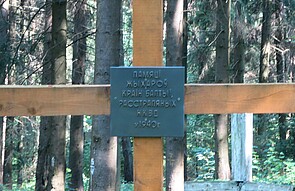
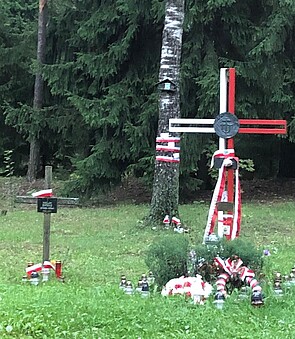
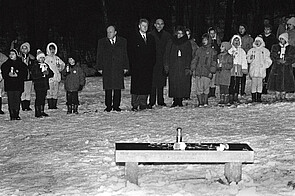
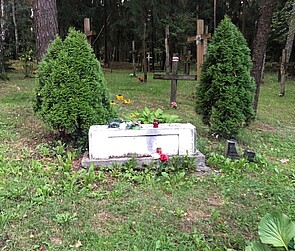
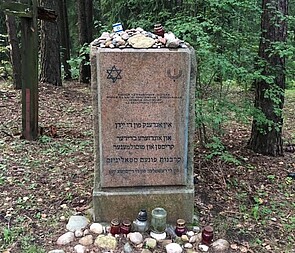
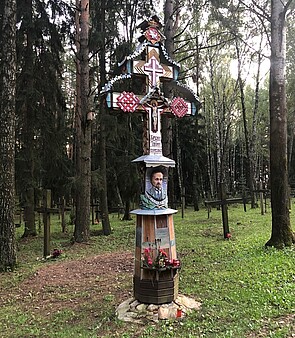
Nelly Bekus · 16.02.2021
Historical Memory and Symbolism in the Belarusian Protests
Read more
Iryna Kashtalian · 11.03.2015
Strangers at Home: Memorialisation of the Armia Krajowa in Belarus
Read more
Aliaksei Lastouski · 07.05.2014
Belarus - In the Tight Embrace of the 'Russian World': Belarusian Reactions to Events in Ukraine
Read more
Get this article as PDF download (including pictures).